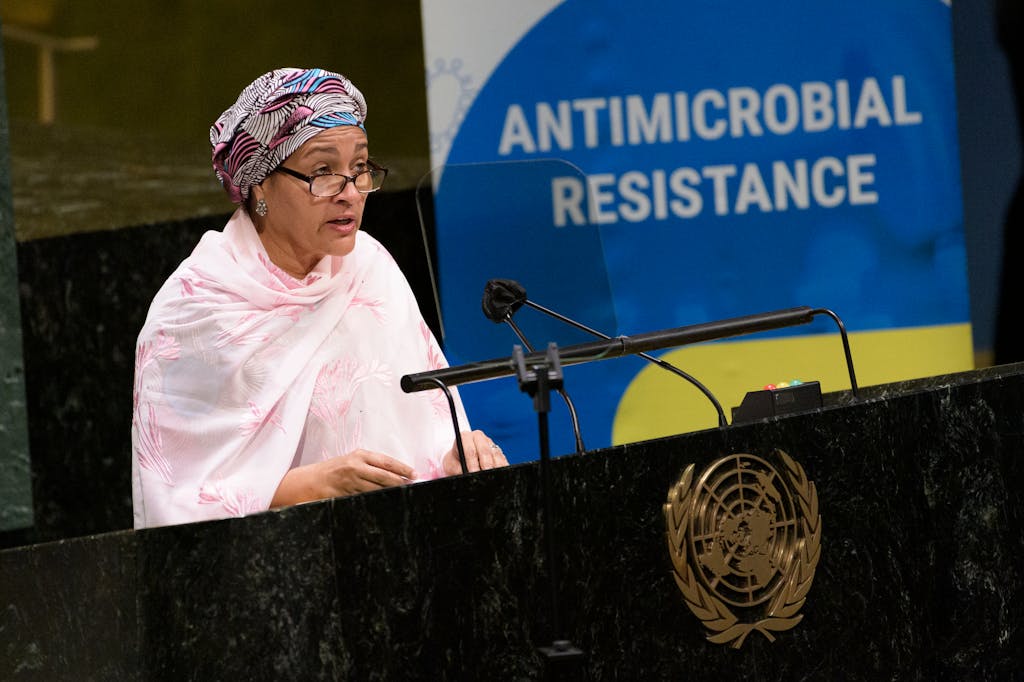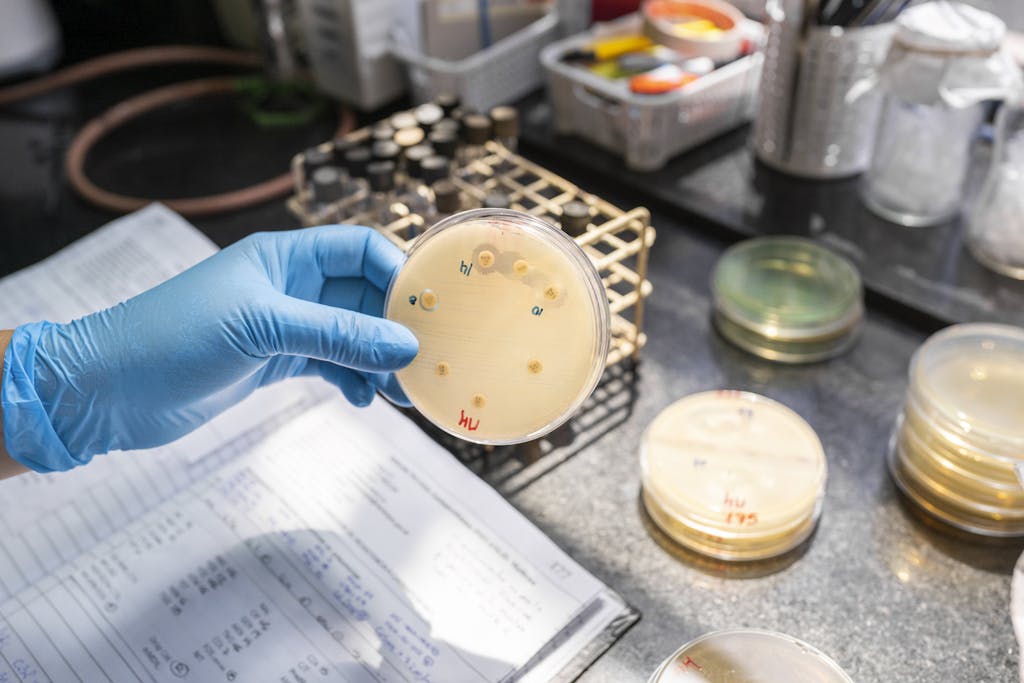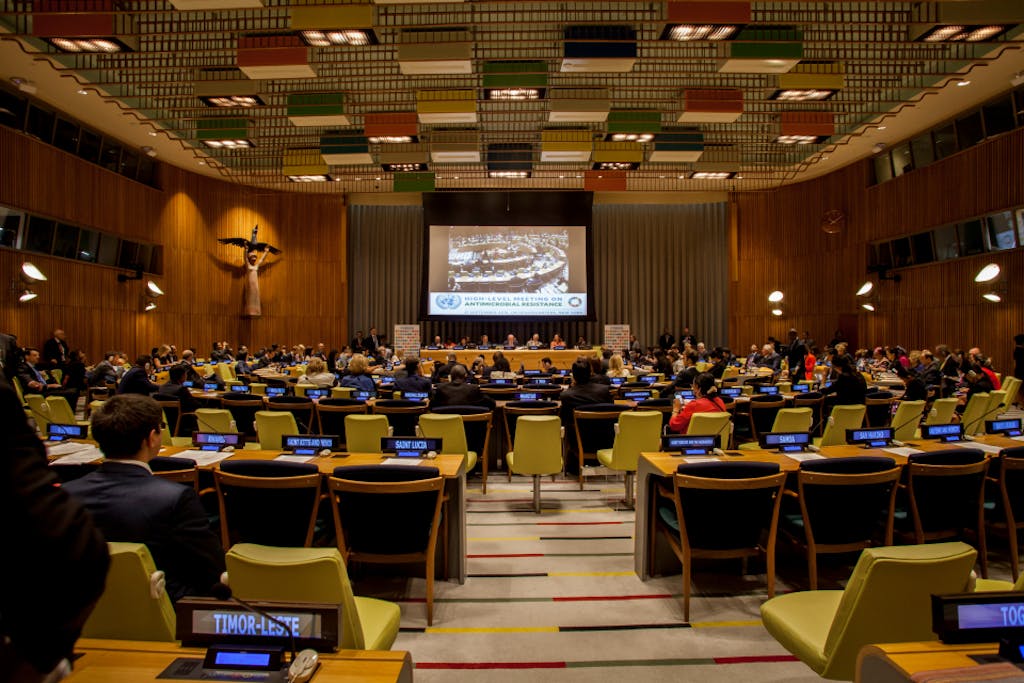Last updated August 28, 2024
Written by: Camden Malone, Global Health Policy Associate, United Nations Foundation
When governments choose to address health issues through the United Nations General Assembly (UNGA) in New York, it signifies that certain challenges merit urgent attention at the highest political levels. On September 26, Heads of State and senior government officials will convene a High-Level Meeting (HLM) on just such an issue – antimicrobial resistance (AMR).
Other pressing health concerns, such as HIV/AIDS, the COVID-19 pandemic, and the achievement of Universal Health Coverage, have all been addressed in this forum in recent years. Each high-level meeting contributes – in small or large ways – to the global policy context for that issue. The inaugural high-level meeting on AMR was held in 2016 and significantly influenced the ways in which the United Nations and its Member States respond to this complex and multisectoral threat. Now, eight years later, Member States will again come together to sign off on a political declaration that will guide future policy initiatives at global, regional, and national levels for years to come.

Antimicrobial resistance is a complex phenomenon in which bacteria, viruses, fungi, and parasites change over time and no longer respond to the medicines used to fight against them. The result is higher risks of disease and increased difficulty in treating infections. AMR kills roughly 4.95 million people each year, one in five of whom are children under five. Although it is exacerbated by human behaviors, AMR is naturally occurring and cannot be entirely prevented. The long-term, accelerating risk posed by AMR is why some experts are describing the threat as the ‘grand pandemic.’
Antibiotics are a cornerstone of modern medicine. But inappropriate and excessive use of antibiotics across all sectors continues to drive the development of resistance. Since 2000, global antibiotic consumption has increased by 46%. In some countries, approximately 80% of the total consumption of medically important antibiotics occurs in the animal sector, mainly for growth promotion. Several practices in plant agriculture and crop production are also shown to increase environmental transmission of drug-resistant microbes to humans. At the same time, the climate crisis is magnifying the scope of the AMR emergency, increasing the spread of infectious diseases and wreaking havoc on health, water, and waste management systems.
The burden of AMR is also attributable to a lack of access to vaccines, diagnostics, and the most-effective antibiotics. Without adequate tools for properly diagnosing and treating infections, medical practitioners often inadvertently prolong regimens and promote over- and misuse of antibiotic drugs that hinder effective treatment and drive the development of resistance. Of the 254,000 children under the age of five that died from resistant infections in 2019 (one child every two minutes), more than 99% were from low- and middle-income countries (LMICs), primarily due to a lack of access to basic health services.
Overall, preventing the spread and emergence of AMR is best achieved by a suite of interventions such as improvements to water, sanitation, and hygiene (WASH), infection prevention and control (IPC), stewardship, and a robust pipeline for developing novel antibiotics and procuring existing ones, along with vaccines and diagnostics. Through a comprehensive multilateral and multisectoral approach, the need for using antibiotics in the first place can be greatly reduced. Operationalizing these approaches, however, is no easy task. Strong commitments and a coordinated strategy from governments is needed, and this is why a high-level meeting on AMR will be convened under the auspices of the UN General Assembly in September.

There is a good rationale behind elevating this issue to the world’s largest diplomatic stage. First, approaches to AMR require cohesion and synergy across the One Health spectrum of human, animal, and environmental sectors. Second, the unique architecture of the UN system is well-suited to contribute to both the development and implementation of solutions, as it is a forum for all countries – regardless of income or capacity – to commit to important policy decisions.
Three high-level meetings on health-related issues in 2023 demonstrated the growing salience of health in the broader global policymaking context, and this year, a second high-level meeting on AMR will maintain the momentum on health diplomacy in New York.
Outcomes of the first-ever high-level meeting on AMR in 2016 lay a foundation for this year’s meeting to build upon, and underscore diplomats’ capacity to advance global health through New York processes. Commitments prompted the creation of key global governance structures, including the Global Leaders Group and Multi-Stakeholder Partnership Platform, and a surge in the percentage of countries with National Action Plans (NAPs) from roughly one-third to three-quarters in just a five-year span.
The 2016 HLM also set in motion the formation of an interagency partnership between the World Health Organization (WHO), Food and Agriculture Organization (FAO), World Organisation for Animal Health (WOAH), and UN Environment Programme (UNEP) – now titled the Quadripartite Joint Secretariat. The partnership has since developed a joint strategy for enhancing cooperation and leveraging comparative advantages across the UN system to strengthen the global response to AMR. These advancements remind that the UN is not only a host for changemaking at the highest levels; it is also the beneficiary of many such reforms.

The success of any high-level meeting is often measured by the strengths and weaknesses of its outcome document, or ‘political declaration.’ As of this writing, the AMR political declaration is still being negotiated. The text will then be provisionally approved by Member States at the high-level meeting and officially adopted in early October.
The first draft of the text contains several concrete commitments across AMR governance, financing, research and development (R&D), and measures to expand access that build on current progress and stimulate new, innovative approaches. Perhaps most notable is the north-star target to reduce AMR-caused deaths globally by 10% by 2030.
To assist with achieving this target and several other goals by the end of the decade, countries are committing to have NAPs and for 60% to be adequately financed (compared to the roughly 20% to date).
Another important element of the text is the request for the Quadripartite to establish an Independent Panel on Evidence for Action. If created, the panel will complete some of the governance reforms that were initiated through the 2016 high-level meeting. The panel would serve a key function by supporting Member States’ decision making with regular guidance on the trends of science, data, and evidence across AMR-related sectors.
The difficulty of negotiating an impactful political declaration should not be underestimated. Delegates must navigate a highly technical topic that requires complex coordination among countries in a very tumultuous political environment. The inclusion of several specific numeric targets in the document is ambitious in comparison to many past political declarations. Targets create clearer pathways to hold governments accountable to their commitments, and consensus on targets is often elusive for this reason. But even a strong outcome document with lots of concrete provisions is still not a panacea for a threat as colossal and imminent as AMR. Sustained action in the form of collaboration to implement the political declaration will be key to future success in curbing AMR and saving lives down the road.
Member States anticipate having the next high-level meeting on AMR in 2029. The political declaration to be agreed on in September will serve as a compass to guide collective action over the next five years. UNGA79 is a pivotal moment to garner political will for curbing the rising threat of resistance and an abutment for the arc of opportunities to deliver five more years of policies and actions that steer us further away from a post-antibiotic future.
We invite you to join the AMR Communications Coordination Hub, a mechanism convened by the UN Foundation and funded by the Wellcome Trust to align messaging and share insights in preparation for the UN High-Level meeting on AMR. The Hub is a is a time-bound effort that aims to support the work of current initiatives, including the Multi-Stakeholder Partnership Platform. In the coming months, we will share regular updates, resources, and engagement opportunities through the Hub. Email AMR-CC@unfoundation.org to join.
Camden Malone advances the global health agenda through engagement with UN Member States on a wide range of health policy issues, including universal health coverage, antimicrobial resistance, and pandemic preparedness, prevention, and response. Prior to the United Nations Foundation, Camden worked at the Permanent Mission of Costa Rica to the UN, covering intergovernmental negotiations related to health and human rights. Camden holds a master’s degree in International Affairs from the Colin Powell School for Civic and Global Leadership at the City College of New York; and a bachelor’s degree in History and Political Science from the College of Saint Rose.
To get the latest Global Health news from our experts, subscribe to our monthly newsletter.